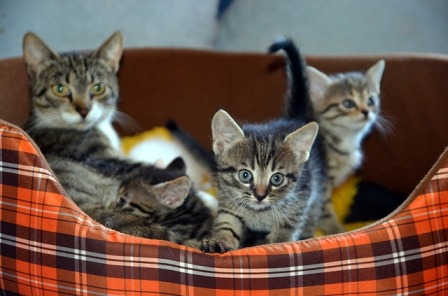How to Teach Kitten to Use Litter Box
How to Teach Kitten to Use Litter Box
Teaching a kitten to use litter box should not be a complex undertaking. They instinctively bury their feces to hide traces from greater predators. In nature, there are no coincidences. Every behavior has developed with some purpose. However, if a young kitten has not learned from its mother where to pee or poop and how to dig it in, it will most probably do it in the wrong places. To help kitten learn to use the litter box the first step is to choose the right size. Kittens like to have space when entering litter box, and that is why cat experts suggest providing the cat with an appropriate size. It is also important to choose a litter box with the front door that are accessible to the young kitten and easy to enter. Cat experts also suggest placing the litter box in a quiet and peaceful area, where the kitten will feel comfortable. If a litter box is located in a busy place, the kitten will avoid it and most probably make an accident. To teach the kitten how to use the litter box, the article “How to Litter Train a Cat” offers three practical steps.
How to Teach Kitten to Use Litter Box
Learn your cat’s schedule. Generally speaking, a cat will need to relieve himself after taking a nap, after he’s been playing or running around, or after he’s eaten. Learning your cat’s schedule will help you determine when he’s most likely to relieve himself so you can direct him to the litter box instead of the sofa.
Play with your cat near the box. Since many cats need to eliminate after playing and running around, you can facilitate the process by playing with your cat near his litter box. If his box is in a room with a door, close the door and stay in the room with him. Bring some of his toys in and let him chase or pounce on his toys. The activity will most likely leave him needing to eliminate, at which point you can direct him to (or even place him in) the litter box.
Teach him what to do. If your cat never learned to use a litter box from his mother, you may need to help show him how it’s done. That doesn’t mean actually using the litter box yourself; rather, you’ll have to carry him to the litter box when he’s about to eliminate, and teach him how to dig in the litter. Use a finger to scrape some litter aside until he learns by example. If your cat eliminates in the box but hasn’t learned to bury it, use your finger to scoop a little litter on top of his waste. It will take time, but eventually he’ll understand that you expect him to learn these behaviors.
Cats are clean animals with an incredible sense of smell. Because of that, the young kitten can refuse to enter the soiled litter box and relieve itself in an inappropriate place. For every cat owner, keeping cat’s litter tray clean and fresh is a must. It is highly advisable to pick up the hard clumps of kitten feces frequently, at least daily. To keep the litter box clean, it is necessary to wash it thoroughly once a week. Cat experts do not recommend using strong chemicals that can irritate the cat and turn it away from the litter tray. Soap and warm water will be enough if the litter box maintains regularly. Cats, also, do not like food and water close to the litter tray. Therefore, clean litter tray of the right size, in a quiet place, and far away from food and water will ensure that the young kitten will develop good toilet habits.










